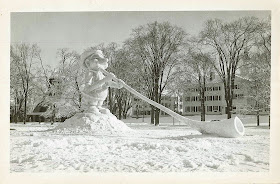 In 1951, Popular Science featured Dartmouth students under the headline “How the Experts Build a Snow Man.” That year's Winter Carnival snow sculpture was the Alpendoodler, an odd little man blowing an enormous alpenhorn. The sculpture was formed with wire mesh and birch logs covered with slush.
In 1951, Popular Science featured Dartmouth students under the headline “How the Experts Build a Snow Man.” That year's Winter Carnival snow sculpture was the Alpendoodler, an odd little man blowing an enormous alpenhorn. The sculpture was formed with wire mesh and birch logs covered with slush. Since the 1920s, snow sculptures on the Green have served as focal points for Winter Carnival. Each year Dartmouth students have puzzled, schemed, designed and built wondrous sculptures. They vary from the absurd to the sublime. There are feats of engineering that leave you awed, whimsy that makes you laugh, special effects to thrill, and even a Guinness World Record. We currently have some our favorite “Center of the Green” snow sculptures from 1924 to 1987 on exhibit to celebrate the artistry and expertise of Dartmouth’s snowman builders.
Come into Rauner before this year's sculpture melts to take a look! The exhibit will run through March 1st. To see how the Popular Science article, ask for DC Hist LD1441 .E643.



